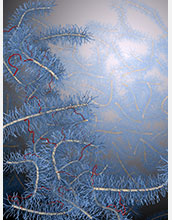Multimedia Gallery
New ultra-soft, dry silicone rubber
This ultra-soft elastomer fabricated by crosslinking bottlebrush polymers contains only crosslinks (red chains) and no entanglements.
More about this image
Medical implants mimic the softness of human tissue by mixing liquids such as oil with long, silicone polymers to create a squishy, wet gel. While implants have improved dramatically over the years, there is still a chance of the liquid leaking, which can be painful and sometimes dangerous.
A research team led by David A. Weitz, the Mallinckrodt Professor of Physics and Applied Physics at the Harvard John A. Paulson School of Engineering and Applied Sciences (SEAS) and an associate faculty member at the Wyss Institute for Biologically Inspired Engineering at Harvard, has developed a way to create an ultra-soft, dry silicone rubber. The new rubber features tunable softness to match a variety of biological tissues, thereby opening new opportunities in biomedical research and engineering.
"Conventional elastomers are intrinsically stiff because of how they are made," says Li-Heng Cai, a postdoctoral fellow at SEAS. "The network strands are very long and are entangled, similar to a bunch of Christmas lights in which the cords are entangled and form knots. These fixed entanglements set up an intrinsic lower limit for the softness of conventional elastomers."
In addition to controlling the softness, the team also found a way to independently control the liquid-like behavior of the elastomer. The researchers can adjust the length of "hairy" polymers on the bottlebrush molecules to tune the liquid-like behavior of soft elastomers -- without swelling, thereby allowing them to make these elastomers exceptionally non-adhesive yet ultra-soft. These qualities make the material not only ideal for medical devices, such as implants, but also for commercial products such as cosmetics.
This research was supported in part by the National Science Foundation (grant DMR 13-10266) and the Harvard Materials Research Science and Engineering Center (grant DMR 14-20570), an NSF Materials Research Science and Engineering Center.
To learn more, see the Harvard news story Eliminating entanglements. (Date image taken: unknown; date originally posted to NSF Multimedia Gallery: Jan. 6, 2016)
Credit: Li-Heng Cai, Harvard University
Images and other media in the National Science Foundation Multimedia Gallery are available for use in print and electronic material by NSF employees, members of the media, university staff, teachers and the general public. All media in the gallery are intended for personal, educational and nonprofit/non-commercial use only.
Images credited to the National Science Foundation, a federal agency, are in the public domain. The images were created by employees of the United States Government as part of their official duties or prepared by contractors as "works for hire" for NSF. You may freely use NSF-credited images and, at your discretion, credit NSF with a "Courtesy: National Science Foundation" notation.
Additional information about general usage can be found in Conditions.
Also Available:
Download the high-resolution JPG version of the image. (7 MB)
Use your mouse to right-click (Mac users may need to Ctrl-click) the link above and choose the option that will save the file or target to your computer.



